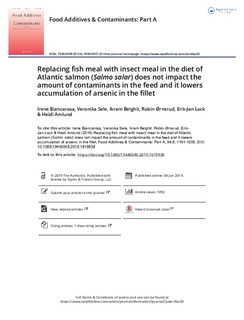| dc.description.abstract | Insects are promising sources of protein and lipid in feeds for farmed animals. In the European Union, the use of insect meal (IM) and insect oil is permitted in fish feed. However, the European Food Safety Authority has highlighted the lack of data regarding the chemical safety of insects and products thereof. In this study, Atlantic salmon (Salmo salar) were fed diets in which fish meal (FM) was partially or fully substituted with IM, resulting in four diets with an FM replacement of 0%, 33%, 66% and 100% by IM. The IM was produced from Black soldier fly (Hermetia illucens) larvae fed media containing 60% seaweed (Ascophyllum nodosum). After 16 weeks of feeding, fish fillet samples were collected. The concentrations of undesirable substances, e.g., heavy metals, arsenic, dioxins, mycotoxins, pesticides, in the IM, the diets and fillets were determined. The concentrations of the analysed compounds in the IM were all below EU maximum levels for feed ingredients, except for arsenic. However, for complete feeds the concentrations of these compounds in the feeds, including arsenic, were all below EU MLs. Arsenic was transferred from seaweed to IM, resulting in arsenic levels in IM similar to what has been documented for FM. Transfer of arsenic from feed to fillet was observed; however, total arsenic concentrations in the fillet significantly decreased when fish were fed diets with more IM and less FM. Arsenic speciation analysis of the diets showed that although total arsenic levels were similar, the arsenic species were different. Arsenobetaine was the major organoarsenic species in the diets containing FM, while in diets containing IM several unidentified arsenic species were detected. The results suggest that the lower feed-to-fillet transfer of arsenic when FM is replaced by IM may be due to the presence of arsenic species with low bioavailability in the IM. | nb_NO |
